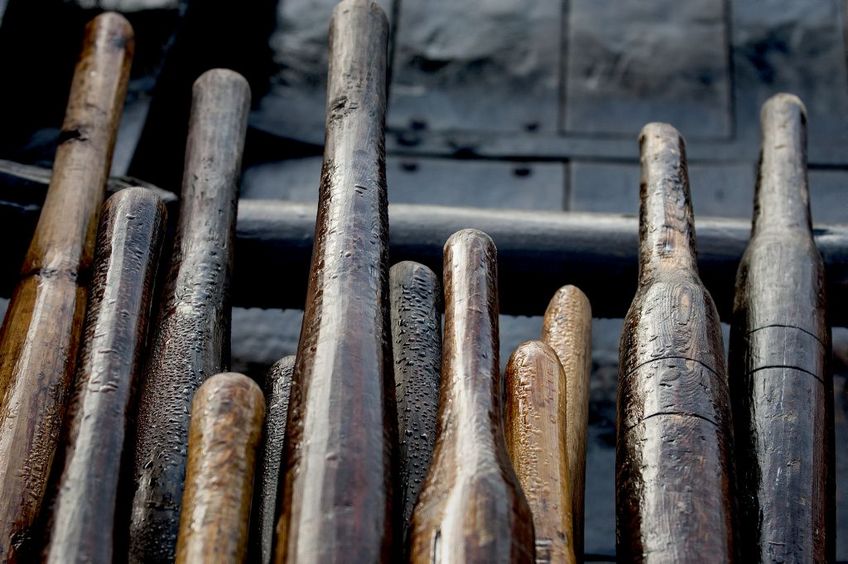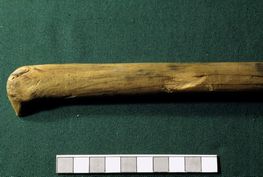
Source criticism
Written Sources
The written sources are indispensable to us when writing Viking history, but they do present us with a number of critical problems. There are very few contemporary Scandinavian sources and so we have to work back from later accounts, laws and chronicles, and make use of unreliable and prejudiced foreign sources if the history of the Vikings is to be based on the written source material.
One problem common to all the written sources is that many of them are preserved only in later copies or in translation, which means there may be errors or alterations to the original text. Words may be missing, later words or concepts added, and the more recent text may show the influence of religious, political and historical ideas of the author’s own time. No historian can be objective and avoid interpreting the past in the light of current needs. People will always try to create a picture of history in keeping with their own self-conception.
The value of a source thus depends on the author. In foreign chronicles and travelogues, the Vikings were not usually the main theme, and the history written about the people, traditions and customs of Scandinavia was coloured by the author’s own cultural background.
Christian writers could not set aside their Christian outlook, and Irish and Frankish annals in particular show that there was no understanding of the heathen Scandinavian way of living. Peaceful events were rarely described, but rather the dramatic plundering and conquests, great battles, killings, abductions and political alliances.
Poems of the Viking Age
But a source is not necessarily reliable just because it is contemporary.
Viking skaldic (bardic) and heroic poems can be hard to understand and to date. It can be difficult to sift the contents and tell whether the whole narrative is truthful. Are we being given information about society in general or merely local customs and traditions? Are the names of kings and heroes correct, but the stories about them fiction?
The mythological and heroic poems often have an associative style of narrative; the audience was familiar with the events related and this meant that the narrator could conjure up an image in the minds of his listeners using very few words. This makes modern reconstruction difficult, and we depend on later prose re-workings of the poems.
The more direct style of the scaldic poems makes them easier to date. The texts are not as anonymous, but contain the names of kings and heroes, place names and descriptions of internal struggles or great battles. The language, however, can be difficult. In their poems the scalds use kennings – conventional metaphors for everyday concepts, which create a somewhat dramatic and poetic tone. To understand these kennings we have to grasp the poet’s and the Vikings’ world and its imagery.
Many of the source-critical problems associated with the written material can be tackled by comparison of the various sources. The sources can confirm or contradict one another.
Archaeological finds
Unlike other sources, the number of archaeological sources increases all the time. Just as in the case of written source criticism, it is necessary in our interpretation to bear in mind what has gone before: the circumstances of the find, and the excavation and recording methods used.
Developments in techniques and documentation
Archaeological techniques have changed enormously over the last twenty years, in line with technological development. In the nineteenth century, Denmark’s historical monuments were recorded in parish descriptions nationwide. Now the old hand-written and illustrated archives have been digitised. This process involved a subjective selection of essential information. Users of digital archives about ancient monuments need to keep in mind therefore that they may not represent a complete picture of their subject.
The working methods and excavation techniques of archaeologists are often subjective or dictated by the leader of the excavation. A site is documented by several archaeologists using different techniques, and after the excavation a report is prepared on the objects discovered and other traces, such as post holes and fire places. At each new stage a new interpretation may emerge.
As a result of technological developments, GPS receivers are used at many excavations nowadays. One criticism of the use of GPS is that the technology creates an idealised image of the site. In the measurement and recording of a post hole, some points in the hole are entered into the GPS, which then draws a round hole. But were the post holes as perfectly round as they are drawn on the GPS?
GPS users believe that the differences that arise in the precise delineation in digital as opposed to analogue measurement are so small that they have no implications for the overall interpretation. The use of GPS also opens up the possibility that information from other electronic tools can be applied directly at the site location. This speeds up the work process and the interpretation that follows can take place on site and closer to the actual find.
Metal Detectors
If an archaeologist works with a metal detector, there is a danger that the objects collected will not give a representative picture of the area or settlement. 95% of the detector’s positive reactions are due to iron on the surface, but often most objects collected are gold, silver or bronze. Collecting surface finds with a detector thus is a bit like a treasure hunt in which only rare and exciting objects are found. Such selection of ‘special’ objects can give a false picture of the use of materials in the area.
In combination with written and pictorial sources, an archaeological source acquires a value greater than that of the specific object itself. If the find is correctly interpreted and dated, it can write history. A classic example is that of contact between Scandinavia and the Roman Empire. As there are no Scandinavian written sources from this period, one could be led to believe that there was no contact between those two parts of Europe. But archaeological finds clearly show that there was.
Pictorial sources
For modern people with computers, films and 3D animations, it can be hard to understand the imagery intended by an artist 1000 years ago. The pictures are not naturalistic, as they often are today, and the artist’s symbolism may not be clear to us unless we already possess considerable knowledge of the pictorial style, trends and artistic schools of the Viking age. Will people understand our graffiti a thousand years from now?
The meaning of symbols is moreover time-dependent and is often interpreted in the light of current perceptions. It is therefore important to think out how the picture was meant to be used. A good example is the swastika, which has become a negative symbol to us because of its use by the Nazis. In ancient times, however, the swastika was thought of as a sun symbol.
During the excavation of nine ships in Roskilde Harbour in 1997, a rune stick was found. It lay underneath one of the ships, Roskilde 6. In one end the stick had been rudely carved as a mammal or bird. At the other end, a stone had been fastened. Some of the runic text was destroyed, but the rest said: "Sakse carved these runes, ...man."
But is this, then, a written source? Is it an iconographic source? An archaeological artefact? All three? - That depends on what you want to know!
No one knows, what the stick was for. Was it a primitive tool, a hammer? Was it magical? Was it a message? Or perhaps just a toy?
Did you know?
That Snorri's Edda is recognised today as a valid source for the concepts, rules, writing traditions and content that we find in the mythological and heroic poems.
By: Louise Kæmpe Henriksen
